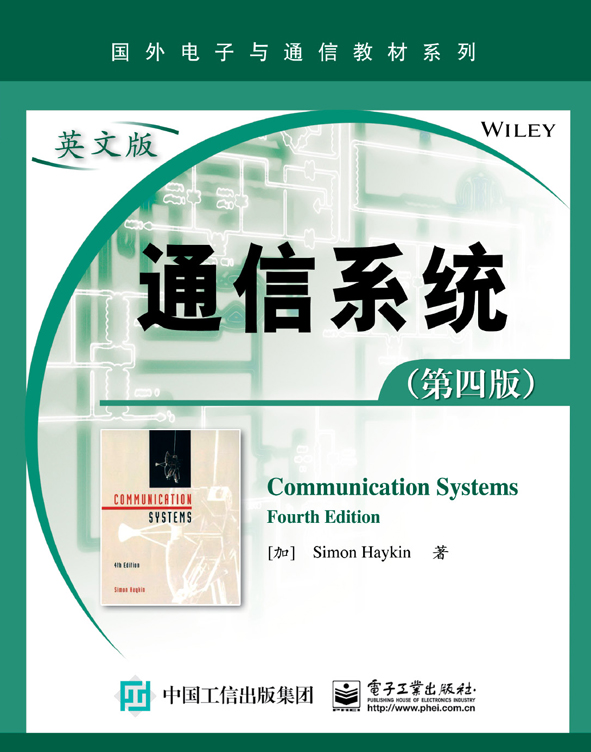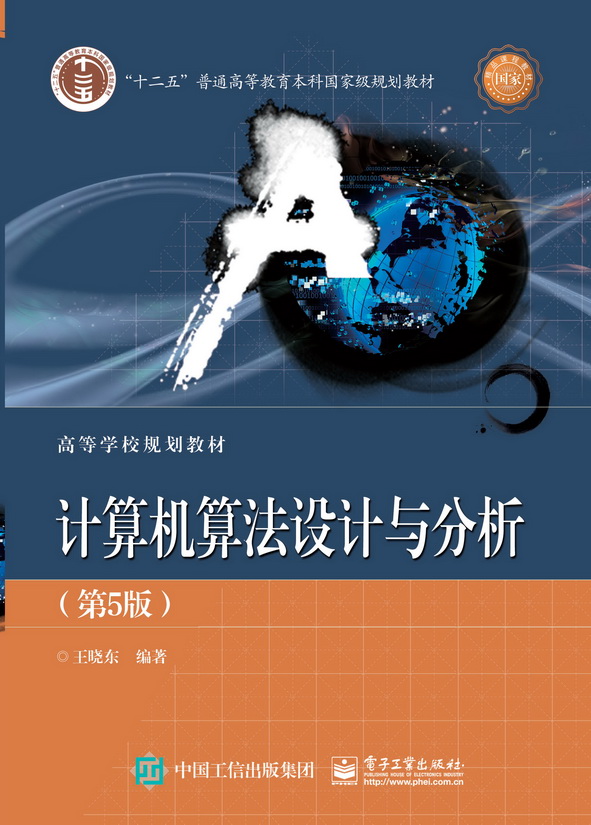通信系统(第四版)(英文版)
作 译 者:Simon Haykin (西蒙·赫金)
出 版 日 期:2015-03-01
书 代 号:G0255870
I S B N:9787121255878
图书简介:
本书向授课教师提供英文原版教辅(习题解答,PPT),具体申请方式请咨询te_service@phei.com.cn。本书对通信系统的基础理论和关键环节进行了深入分析,力图让学生在讨论中领会通信的精髓。全书首先给出通信系统的梗概及需要研究的关键技术,接着分章详细讨论了随机过程、连续波调制、脉冲调制、基带脉冲传输、信号空间分析、带通数字传输、扩频调制、多用户无线通信、信息论基础和差错控制编码等,各章都附有大量的习题,便于学生实践。本书强调通信理论的统计基础,并给出了用MATLAB模拟的8个计算机实验,这些实验几乎覆盖了各章节的主要内容,形成了独特的通信理论“软件实验室”。
定价 99.0
您的专属联系人更多
联系人:马老师
电话:4557
邮箱:malan@phei.com
-
配 套 资 源图书特别说明:由于成本考虑,本书不作为参考书赠送。如果确有授课教材选用的需求,可将详细情况发送给本书专属联系人,我们将进一步沟通并酌情处理。
本书资源
本书暂无资源会员上传本书资源
-
图 书 内 容
内容简介
本书向授课教师提供英文原版教辅(习题解答,PPT),具体申请方式请咨询te_service@phei.com.cn。本书对通信系统的基础理论和关键环节进行了深入分析,力图让学生在讨论中领会通信的精髓。全书首先给出通信系统的梗概及需要研究的关键技术,接着分章详细讨论了随机过程、连续波调制、脉冲调制、基带脉冲传输、信号空间分析、带通数字传输、扩频调制、多用户无线通信、信息论基础和差错控制编码等,各章都附有大量的习题,便于学生实践。本书强调通信理论的统计基础,并给出了用MATLAB模拟的8个计算机实验,这些实验几乎覆盖了各章节的主要内容,形成了独特的通信理论“软件实验室”。图书详情
ISBN:9787121255878开 本:16开页 数:836字 数:1522本书目录
BACKGROUND AND PREVIEW 1. The Communication Process 2. Primary Communication Resources 3. Sources of Information 4. Communication Networks 5. Communication Channels 6. Modulation Process 7. Analog and Digital Types of Communication 8. Shannon's Information Capacity Theorem 9. A Digital Communication Problem 10. Historical Notes Notes and References CHAPTER 1 Random Processes 1.1 Introduction 1.2 Mathematical Definition of a Random Process 1.3 Stationary Processes 1.4 Mean, Correlation, and Covariance Functions .1.5 Ergodic Processes 1.6 Transmission of a Random Process Through a Linear Time-Invariant Filter 1.7 Power Spectral Density 1.8 Gaussian Process 1.9 Noise 1.10 Narrowband Noise 1.11 Representation of Narrowband Noise in Terms of In-phase and Quadrature Components 1.12 Representation of Narrowband Noise in Terms of Envelope and Phase Components 1.13 Sine Wave Plus Narrowband Noise 1.14 Computer Experiments: Flat-Fading Channel 1.15 Summary and Discussion Notes and References Problems CHAPTER 2 Continuous-Wave Modulation 2.1 Introduction 2.2 Amplitude Modulation 2.3 Linear Modulation Schemes 2.4 Frequency Translation 2.5 Frequency-Division Multiplexing 2.6 Angle Modulation 2.7 Frequency Modulation 2.8 Nonlinear Effects in FM Systems 2.9 Superheterodyne Receiver 2.10 Noise in CW Modulation Systems 2.11 Noise in Linear Receivers using Coherent Detection 2.12 Noise in AM Receivers using Envelope Detection 2.13 Noise in FM Receivers 2.14 Computer Experiments: Phase-Locked Loop 2.15 Summary and Discussion Notes and References Problems CHAPTER 3 Pulse Modulation 3.1 Introduction 3.2 Sampling Process 3.3 Pulse-Amplitude Modulation 3.4 Other Forms of Pulse Modulation 3.5 Bandwidth-Noise Trade-off 3.6 Quantization Process 3.7 Pulse-Code Modulation 3.8 Noise Considerations in PCM Systems 3.9 Time-Division Multiplexing 3.10 Digital Multiplexers 3.11 Virtues, Limitations, and Modifications of PCM 3.12 Delta Modulation 3.13 Linear Prediction 3.14 Differential Pulse-Code Modulation 3.15 Adaptive Differential Pulse-Code Modulation 3.16 Computer Experiment: Adaptive Delta Modulation 3.17 MPEG Audio Coding Standard 3.18 Summary and Discussion Notes and References Problems CHAPTER 4 Baseband Pulse Transmission 4.1 Introduction 4.2 Matched Filter 4.3 Error Rate Due to Noise 4.4 Intersymbol Interference 4.5 Nyquist's Criterion for Distortionless Baseband Binary Transmission 4.6 Correlative-Level Coding 4.7 Baseband M-ary PAM Transmission 4.8 Digital Subscriber Lines 4.9 Optimum Linear Receiver 4.10 Adaptive Equalization 4.11 Computer Experiments: Eye Patterns 4.12 Summary and Discussion Notes and References Problems CHAPTER 5 Signal-Space Analysis 5.1 Introduction 5.2 Geometric Representation of Signals 5.3 Conversion of the Continuous AWGN Channel into a Vector Channel 5.4 Likelihood Functions 5.5 Coherent Detection of Signals in Noise: Maximum Likelihood Decoding 5.6 Correlation Receiver 5.7 Probability of Error 5.8 Summary and Discussion Notes and References Problems CHAPTER 6 Passband Digital Transmission 6.1 Introduction 6.2 Passband Transmission Model 6.3 Coherent Phase-Shift Keying 6.4 Hybrid Amplitude/Phase Modulation Schemes 6.5 Coherent Frequency-Shift Keying 6.6 Detection of Signals with Unknown Phase 6.7 Noncoherent Orthogonal Modulation 6.8 Noncoherent Binary Frequency-Shift Keying 6.9 Differential Phase-Shift Keying 6.10 Comparison of Digital Modulation Schemes Using a Single Carrier 6.11 Voiceband Modems 6.12 Multichannel Modulation 6.13 Discrete Multitone 6.14 Synchronization 6.15 Computer Experiments: Carrier Recovery and Symbol Timing 6.16 Summary and Discussion Notes and References Problems CHAPTER 7 Spread-Spectrum Modulation 7.1 Introduction 7.2 Pseudo-Noise Sequences 7.3 A Notion of Spread Spectrum 7.4 Direct-Sequence Spread Spectrum with Coherent Binary Phase-Shift Keying 7.5 Signal-Space Dimensionality and Processing Gain 7.6 Probability of Error 7.7 Frequency-Hop Spread Spectrum 7.8 Computer Experiments: Maximal-Length and Gold Codes 7.9 Summary and Discussion Notes and References Problems CHAPTER 8 Multiuser Radio Communications 8.1 Introduction 8.2 Multiple-Access Techniques 8.3 Satellite Communications 8.4 Radio Link Analysis 8.5 Wireless Communications 8.6 Statistical Characterization of Multipath Channels 8.7 Binary Signaling over a Rayleigh Fading Channel 8.8 TDMA and CDMA Wireless Communication Systems 8.9 Source Coding of Speech for Wireless Communications 8.10 Adaptive Antenna Arrays for Wireless Communications 8.11 Summary and Discussion Notes and References Problems CHAPTER 9 Fundamental Limits in Information Theory 9.1 Introduction 9.2 Uncertainty, Information, and Entropy 9.3 Source-Coding Theorem 9.4 Data Compaction 9.5 Discrete Memoryless Channels 9.6 Mutual Information 9.7 Channel Capacity 9.8 Channel-Coding Theorem 9.9 Differential Entropy and Mutual Information for Continuous Ensembles 9.10 Information Capacity Theorem 9.11 Implications of the Information Capacity Theorem 9.12 Information Capacity of Colored Noise Channel 9.13 Rate Distortion Theory 9.14 Data Compression 9.15 Summary and Discussion Notes and References Problems CHAPTER 10 Error-Control Coding 10.1 Introduction 10.2 Discrete-Memoryless Channels 10.3 Linear Block Codes 10.4 Cyclic Codes 10.5 Convolutional Codes 10.6 Maximum Likelihood Decoding of Convolutional Codes 10.7 Trellis-Coded Modulation 10.8 Turbo Codes 10.9 Computer Experiment: Trubo Decoding 10.10 Low-Density Parity-Check Codes 10.11 Irregular Codes 10.12 Summary and Discussion Notes and References Problems APPENDIX 1 Probability Theory APPENDIX 2 Representation of Signals and Systems APPENDIX 3 Bessel Functions APPENDIX 4 Confluent Hypergeometric Functions APPENDIX 5 Cryptography APPENDIX 6 Tables GLOSSARY BIBLIOGRAPHY INDEX展开前 言
Simon Haykin IEEE会士,加拿大皇家学会会士,毕业于英国伯明翰大学电子工程系。现为加拿大McMaster大学的Distinguished University教授,认知系统实验室主任。2002年获国际无线电科学联盟(URSI)颁发的Henry Booker金质奖章。在无线通信与信号处理领域的多个方面著述颇丰,主要研究方向为自适应信号处理与智能信号处理、无线通信与雷达技术,近年来特别关注认知无线电和认知雷达方面的研究。 本书特点 ● 演示通信理论主要内容的MATLAB实验 ● 新兴数字技术的延伸,如数字用户线(DSL)、无载波振幅调制/相位调制(CAP)及离散多音(DMT)等 ● 数十个将理论与实际通信系统相结合的实例 ● 通过精心组织,系统地指导学生学习从脉冲调制到带通数据传输、从随机过程到差错控制编码等知识。全书以深入浅出的语言向学生传授了深奥的概念。 Preface Electrical engineering education has undergone some radical changes during the past couple of decades and continues to do so. A modem undergraduate program in electrical engineering includes the following two introductory courses: ● Signals and Systems, which provides a balanced and integrated treatment of continuous-time and discrete-time forms of signals and systems. The Fourier transform (in its different forms), Laplace transform, and z-transform are treated in detail. Typically, the course also includes an elementary treatment of communication systems. ● Probability and Random Processes, which develops an intuitive grasp of discrete and continuous random variables and then introduces the notion of a random process and its characteristics. Typically, these two introductory courses lead to a senior-level course on communication systems. The fourth edition of this book has been written with this background and primary objective in mind. Simply put, the book provides a modern treatment of communication systems at a level suitable for a one- or two-semester senior undergraduate course. The emphasis is on the statistical underpinnings of communication theory with applications. The material is presented in a logical manner, and it is illustrated with examples, with the overall aim being that of helping the student develop an intuitive grasp of the theory under discussion. Except for the Background and Preview chapter, each chapter ends with numerous problems designed not only to help the students test their understanding of the material covered in the chapter but also to challenge them to extend this material. Every chapter includes notes and references that provide suggestions for further reading. Sections or subsections that can be bypassed without loss of continuity are identified with a footnote. A distinctive feature of the book is the inclusion of eight computer experiments using MATLAB. This set of experiments provides the basis of a "software Laboratory", with each experiment being designed to extend the material covered in the pertinent chapter. Most important, the experiments exploit the unique capabilities of MATLAB in an instructive manner. The MATLAB codes for all these experiments are available on the Wiley Web site: http://www.wiley.com/college/haykin/. The Background and Preview chapter presents introductory and motivational material, paving the way for detailed treatment of the many facets of communication systems in the subsequent 10 chapters. The material in these chapters is organized as follows: ● Chapter 1 develops a detailed treatment of random, or stochastic, processes, with particular emphasis on their partial characterization (i.e., second-order statistics). In effect, the discussion is restricted to wide-sense stationary processes. The correlation properties and power spectra of random processes are described in detail. Gaussian processes and narrowband noise feature prominently in the study of communication systems hence their treatment in the latter part of the chapter. This treatment naturally leads to the consideration of the Rayleigh and Rician distributions that arise in a communications environment. ● Chapter 2 presents an integrated treatment of continuous-wave (CW) modulation (i.e., analog communications) and their different types, as outlined here: (i) Amplitude modulation, which itself can assume one of the following forms (depending on how the spectral characteristics of the modulated wave are specified): ★ Full amplitude modulation ★ Double sideband-suppressed carrier modulation ★ Quadrature amplitude modulation ★ Single sideband modulation ★ Vestigial sideband modulation (ii) Angle modulation, which itself can assume one of two interrelated forms: ★ Phase modulation ★ Frequency modulation The time-domain and spectral characteristics of these modulated waves, methods for their generation and detection, and the effects of channel noise on their Performances are discussed. ● Chapter 3 covers pulse modulation and discusses the processes of sampling. quantization, and coding that are fundamental to the digital transmission of analog signals. This chapter may be viewed as the transition from analog to digital communications. Specifically, the following types of pulse modulation are discussed: (i) Analog pulse modulation, where only time is represented in discrete form: it embodies the following special forms: ★ Pulse amplitude modulation ★ Pulse width (duration) modulation ★ Pulse position modulation The characteristics of pulse amplitude modulation are discussed in detail, as it is basic to all forms of pulse modulation, be they of the analog or digital type. (ii) Digital pulse modulation, in which both time and signal amplitude are represented in discrete form; it embodies the following special forms: ★ Pulse-code modulation ★ Delta modulation ★ Differential pulse-code modulation In delta modulation, the sampling rate is increased far in excess of that used in pulse-code modulation so as to simplify implementation of the system. In contrast, in differential Pulse-code modulation, the sampling rate is reduced through the use of a predictor that exploits the correlation properties of the information-bearing signal. (iii) MPEG/audio coding standard, which includes a psychoacoustic model as a key element in the design of the encoder. ● Chapter 4 covers baseband pulse transmission, which deals with the transmission of pulse-amplitude modulated signals in their baseband form. Two important issues are discussed: the effects of channel noise and limited channel bandwidth on the performance of a digital communication system. Assuming that the channel noise is additive and white, this effect is minimized by using a matched filter, with is basic to the design of communication receivers. As for limited channel bandwidth, it manifests itself in the form of a phenomenon known as intersymbol interference. To combat the degrading effects of this signal-dependent interference, we may use either a pulse-shaping filter or correlative encoder/decoder; both of these approaches are discussed. The chapter includes a discussion of digital subscriber lines for direct communication between a subscriber and an Internet service provider. This is followed by a derivation of the optimum linear receiver for combatting the combined effects of channel noise and intersymbol interference, which, in turn, leads to an introductory treatment of adaptive equalization. ● Chapter 5 discusses signal-space analysis for an additive white Gaussian noise channel. In particular, the foundations for the geometric representation of signals with finite energy are established. The correlation receiver is derived, and its equivalence with the matched filter receiver is demonstrated. The chapter finishes with a discussion of the probability of error and its approximate calculation. ● Chapter 6 discusses passband data transmission, where a sinusoidal carrier wave is employed to facilitate the transmission of the digitally modulated wave over a band pass channel. This chapter builds on the geometric interpretation of signals presented in Chapter 5. In particular, the effect of channel noise on the performance of digital communication systems is evaluated, using the following modulation techniques: (i) Phase-shift keying, which is the digital counterpart to phase modulation with the phase of the carrier wave taking on one of a prescribed set of discrete values. (ii) Hybrid amplitude/phase modulation schemes including quadrature-amplitude modulation (QAM), and carrierless amplitude/phase modulation (CAP). (iii) Frequency-shift keying, which is the digital counterpart of frequency modulation with the frequency of the carrier wave taking on one of a prescribed set of discrete values. (iv) Generic multichannel modulation, followed by discrete multitone, the use of which has been standardized in asymmetric digital subscriber lines. In a digital communication system, timing is everything, which means that the receiver must be synchronized to the transmitter. In this context, we speak of the receiver being coherent or noncoherent. In a coherent receiver, provisions are made for the recovery of both the carrier phase and symbol timing. In a noncoherent receiver the carrier phase is ignored and provision is only made for symbol timing. Such a strategy is dictated by the fact that the carrier phase may be random, making phase recovery a costly proposition. Synchronization techniques are discussed in the latter part of the chapter, with particular emphasis on discrete-time signal processing. ● Chapter 7 introduces spread-spectrum modulation. Unlike traditional forms of modulation discussed in earlier chapters, channel bandwidth is purposely sacrificed in spread-spectrum modulation for the sake of security or protection against interfering signals. The direct-sequence and frequency-hop forms of spread-spectrum modulation are discussed. ● Chapter 8 deals with multiuser radio communications, where a multitude of users have access to a common radio channel. This type of communication channel is well represented in satellite and wireless communication systems, both of which are discussed. The chapter includes a presentation of link budget analysis emphasizing the related antenna and propagation concepts, and noise calculations. ● Chapter 9 develops the fundamental limits in information theory, which are embodied in Shannon's theorems for data compaction, data compression, and data transmission. These theorems provide upper bounds on the performance of information sources and communication channels. Two concepts, basic to formulation of the theorems, are (1) the entropy of a source (whose definition is analogous to that of entropy in thermodynamics), and (2) channel capacity. ● Chapter 10 deals with error-control coding, which encompasses techniques for the encoding and decoding of digital data streams for their reliable transmission over noisy channels. Four types of error-control coding are discussed: (i) Linear block codes, which are completely described by sets of linearly independent code words, each of which consists of message bits and parity-check bits. The parity-check bits are included for the purpose of error control. (ii) Cyclic codes, which form a subclass of linear block codes. (iii) Convolutional codes, which involve operating on the message sequence continuously in a serial manner. {iv) Turbo codes which provide a novel method of constructing good codes that approach Shannon's channel capacity in a physically realizable manner. Methods for the generation of these codes and their decoding are discussed. The book also includes supplementary material in the form of six appendices as follows: ● Appendix 1 reviews probability theory. ● Appendix 2, on the representation of signals and systems, reviews the Fourier transform and its properties, the various definitions of bandwidth, the Hilbert transform, and the low-pass equivalents of narrowband signals and systems. ● Appendix 3 presents an introductory treatment of the Bessel function and its modified form. Bessel functions arise in the study of frequency modulation, noncoherent detection of signals in noise, and symbol timing synchronization. ● Appendix 4 introduces the confluent hypergeometric function, the need for which arises in the envelope detection of amplitude-modulated signals in noise. ● Appendix 5 provides an introduction to cryptography, which is basic to secure communications. ● Appendix 6 includes 12 useful tables of various kinds. As mentioned previously, the primary purpose of this book is to provide a modern treatment of communication systems suitable for use in a one- or two-semester undergraduate course at the senior level. The make-up of the material for the course is naturally determined by the background of the students and the interests of the teachers involved. The material covered in the book is both broad and deep enough to satisfy a variety of backgrounds and interests, thereby providing considerable flexibility in the choice of course material. As an aid to the teacher of the course, a detailed solutions manual for all the problems in the book is available from the publisher.展开作者简介
本书暂无作者简介 -
样 章 试 读本书暂无样章试读!
-
图 书 评 价 我要评论









